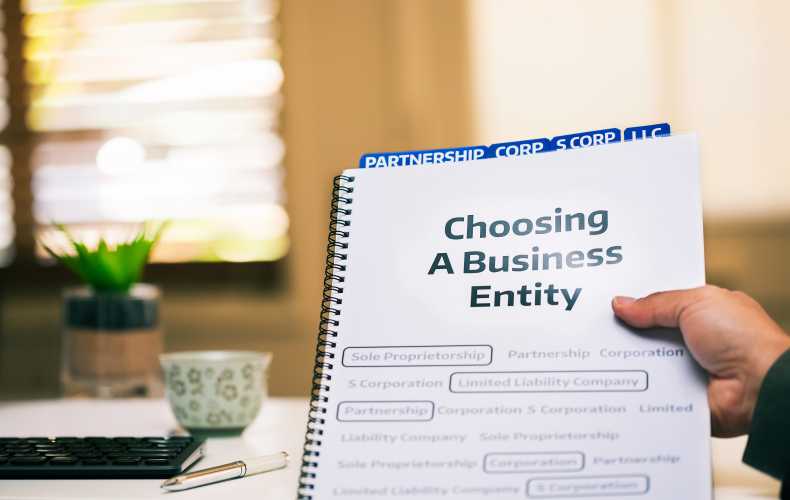How to Choose a Business Structure

So you have an idea for a business; that's great! However, taking the right steps to ensure its success all depends on the type of structure you choose to operate within.
Lots of factors come into play when deciding on a business structure, such as its daily operations, funding, liability, compliance, and taxes. Altogether, it's important to consider how you want to execute each process and set yourself up for consistency and longevity.
Of course, getting started is all about trial and error, but there are a few things you can do to protect yourself along the way. If you're ready to transform your concept into a full-on career move, here's what you can do to choose the right business structure to support it:
What Business Structure is Best for You?
Now that you have a business idea ready to deploy, your first task is to decide on what business structure is best for you.
Depending on what your long-term goals are, there are several business structures that offer different kinds of advantages, protections, and legal separations. In addition, if you plan to run a business with a partner or several partners, that will also dictate the type of structure you need to keep things organized accordingly. For example, you need to choose a business structure before you can...
In any case, your main goal is to keep yourself and your business protected, so if you're ready to get to work, consider these business structures to help you set things in motion:
A Sole Proprietorship
Perhaps the easiest business structure to set up, a sole proprietorship is a common choice for many business owners because it doesn't require a separate registration to form a legal entity.
When you decide to embark on a sole proprietorship, your business assets and liabilities are considered the same as your personal ones. This means that if you're sued or your business fails with outstanding debts still in place, you may be held personally liable to repay banks and investors. Of course, this can be a real threat to your success, but running a sole proprietorship also comes with fairly low risk. Here are some key points to consider:
- You run the business by yourself
- Startup costs are typically less than $100 (setting up a DBA and running an announcement in a local newspaper)
- Taxes are easy to file
- You may need certain licenses and permits depending on your industry
- You can still hire employees
Although there are several benefits, the main drawbacks to running a sole proprietorship often come down to funding. Banks are less likely to give loans to sole proprietorships, and again, if your business goes under, your personal assets are at risk.
Partnership
If you plan to run a business with a partner or multiple partners, then a partnership is a good choice.
Within this business structure, there are two types of partnerships that you can choose from:
- A Limited Partnership (LP): You have one main partner with unlimited liability, whereas other partners have limited liability. Any partners with limited liability have less stake in making decisions for the business. However, the main partner is also subject to paying self-employment taxes for the business.
- A Limited Liability Partnership (LLP): Every partner of the business has limited liability against the actions of other partners. For example, if a partner acquires a huge debt on behalf of the business, others won't be liable to pay it back if the business fails.
Although the structure offers some protections against any negative outcomes, there are still several things you should execute and consider before you make a deal. For a successful partnership to form, make sure you...
- Establish a fair agreement with equal responsibilities and liabilities (with the supervision of attornies)
- Work with a partner you can trust and has a strong financial reputation (good credit score, no outstanding debts or past history of legal trouble)
- File taxes accordingly and share all profits and losses with your partner's filings
Overall, a partnership is a great choice for multiple owners, as well as being a safe way to try out a business idea without taking on the full responsibilities of a major arrangement.
Limited Liability Company (LLC)
If you're wanting to execute a formal business agreement with a partner, then a Limited Liability Company (LLC) is your best bet.
With the combined benefits of a corporation and partnership frameworks, an LLC separates your personal assets from your business and doesn't place you at risk in the event that your business fails or gets sued. In addition, you can enjoy several advantages come tax season that other structures can't offer:
- LLCs are still considered a "pass-through" tax entity
- You're only taxed on your share of the business's profits
- You can form an LLC with just yourself as a member
- LLCs are a great choice to protect a high level of personal assets
On the other hand, there are a few drawbacks that you should weigh, too, that often come down to state compliances and startup costs:
- LLCs are subject to annual compliance costs per state. For example, California charges LLCs $800 annually to maintain their status
- Some states require LLCs to dissolve and re-form when members leave or join
- Members of LLCs are considered as "self-employed" and are subject to tax contributions to Social Security and Medicare
- LLCs are generally more difficult to set up compared to Sole Proprietorships and Partnerships
Altogether, LLCs can result in a business paying a lower tax rate than a corporation with the perks of remaining self-employed on a more formal basis.
Corporations
For a more complex structure with greater flexibility to scale on a wide margin, corporations can be a good choice.
In fact, there are 4 different types of corporations that you can frame your business with, and each one offers different benefits and tax structures to ensure your success. If you're looking to launch a business with ambitious goals to one day become a major influence in your industry, then consider these options when forming:
C Corporation: a business entity that exists separately from its owners, offers firm protections against personal liability issues and can run independently from the influence of shareholders. C Corps are often the most expensive structure to maintain due to double taxation on corporate profits, reporting processes, bookkeeping needs, and overall operations, but they can take advantage of using shares to attract competent employees and potentially take the company "public" and raise capital through the stock market.
S Corporation: S Corps are similar to C Corps, except they are made to bypass the double-taxation rule that C Corp's face. In addition, S Corps have the ability to allow profits and losses to flow through an owner's personal income without falling under corporate tax rates. The only trouble is that every state handles S Corps differently and puts limits on how they can function. For example, a state may tax an S Corp on profits once it passes a certain amount, or they can only have up to 100 shareholders on board who all have to be U.S. citizens.
B Corporation: A B Corp undergoes the same taxation laws as a C Corp, but its structure is different in terms of their purpose and overall accountability. A B Corp is ruled by its mission to benefit the public, along with how it generates revenue. A group of shareholders ensures the B Corp executes successful projects, as well as submits annual reports to some states to maintain compliance. Close corporations are similar to B Corps.
Nonprofit Corporations: These corporations are set up to perform charity work, provide education services, offer religious guidance, or execute literary or scientific work. Nonprofits are the only type of corporation that can receive a "tax-exempt" status since they are designed to work for the public. This means that because of their offerings, they are not subject to state or federal taxes on the profits they earn. They must adhere to the same business structures as a C Corp.
Cooperative or Co-Op
Lastly, a Co-op is a type of business where a specific group of owners run it for the purpose of using its services.
Consider a bike shop where 5 people run it to work on their own bike and provide repair services for a town. Profits from repairs and bike sales are spread evenly to each member, and new members can even join the co-op by buying shares of the business and casting a vote on future initiatives.
Co-ops often have a board of directors who oversee how the business operates, while members have a say in how the board should make decisions.
Compare Your Business Goals to What You've Learned
With so many structures to choose from, all you have to do to make the right decision is to compare your business goals to what you've learned.
Are you a yoga instructor looking to offer freelance sessions at different gyms? Then maybe a sole proprietorship is your best bet. Maybe you want to run a cafe with your best friend; consider starting an LLC to make sure that you're financially protected in case it doesn't work out.
No matter what you decide, you can rest assured that there's a business structure with your best interests in mind. As a general note, if you're unsure of what structure suits you best, or if you have questions regarding the planning and execution of a business structure, it's always a good idea to consult with an accountant or lawyer to ensure compliance.






